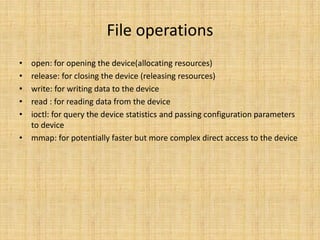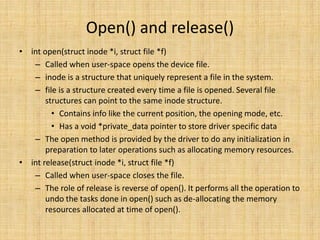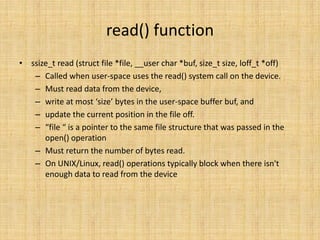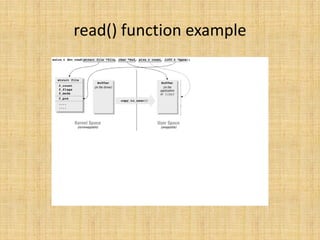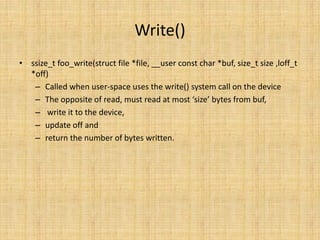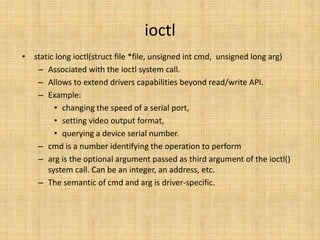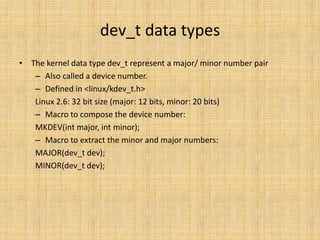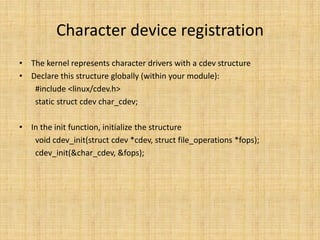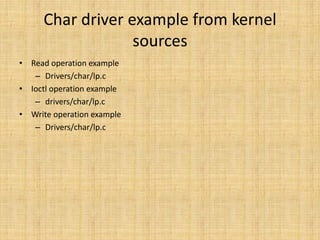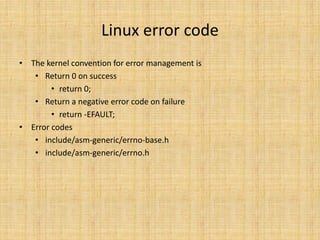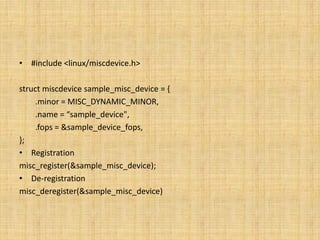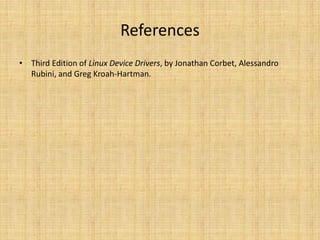Introduction to char device driver
- 1. Writing char device driver ŌĆó Goals ŌĆō Anatomy of character device driver ŌĆō User interface to driver ŌĆó Device files ŌĆō Kernel interface to device driver ŌĆó File operations structure ŌĆó Major and minor number ŌĆō Registering/De-registering char device driver
- 2. Anatomy of device driver ŌĆó A device driver has three sides ŌĆō One side talks to the rest of User the kernel ŌĆō One talks to the hardware and ŌĆō One talks to the user Kernel ┬╗ Device ┬╗ File Device Driver Hardware
- 3. User interface to the device driver ŌĆó A very important Unix design decision was to represent most of the ŌĆ£system objectsŌĆØ as ŌĆ£filesŌĆØ ŌĆó It allows applications to manipulate all ŌĆ£system objectsŌĆØ with the normal file API (open, read, write, close, etc.) ŌĆó So, devices had to be represented as ŌĆ£filesŌĆØ to the applications ŌĆó This is done through a special artefact called a device file ŌĆó It a special type of file, that associates a file name visible to user space applications to the triplet (type, major, minor) that the kernel understands All device files are by convention stored in the /dev directory
- 4. Device file example ŌĆó Device files examples $ ls -l /dev/ttyS0 /dev/sda1 brw-rw---- 1 root disk 8, 1 2012-11-08 19:52 /dev/sda1 crw-rw---- 1 root dialout 4, 64 2012-11-08 19:52 /dev/ttyS0 Example C code that uses the usual file API to write data to a serial port int main() { int fd; fd = open(ŌĆ£/dev/ttyS0ŌĆØ, O_RDWR); write(fd, ŌĆ£HelloŌĆØ, 5); close(fd); }
- 5. Device files ŌĆó In Linux kernel, most of the devices are presented to the user space applications through two different abstractions ŌĆó Character device ŌĆó Block device ŌĆó Internally the kernel identifies each device by a triplet of information ŌĆó Type (character or block) ŌĆó Major number (typically the category of devices) ŌĆó Minor number (typically the identifier of the device)
- 6. Types of devices ŌĆó Block devices ŌĆō A device composed of fixed-sized blocks, that can be read and write to store data. ŌĆō Used for hard disks, SD cards etc. ŌĆó Character devices ŌĆō An infinite stream of bytes, with no beginning, no end, no size. For e.g. serial port. ŌĆō Used for serial ports, terminals etc. ŌĆō Most of the devices that are not block devices are represented by linux kernel as character device.
- 7. Creating device files ŌĆó On a basic Linux system, the device files can be created manually using the mknod command ŌĆó mknod /dev/<device> [c|b] major minor ŌĆó Needs root privileges ŌĆó Coherency between device files and devices handled by the kernel is left to the system developer ŌĆó On more elaborate Linux systems, mechanisms can be added to create/remove them automatically when devices appear and disappear ŌĆó devtmpfs virtual filesystem, since kernel 2.6.32 ŌĆó udev daemon, solution used by desktop and server Linux systems ŌĆó mdev program, a lighter solution than udev
- 8. Kernel interface to the device driver ŌĆó In order to talk to the kernel, the driver registers with subsystems Kernel to respond to events. Such an event might be the opening of a Event List file, closing a file, a page fault, the File open File close X X plugging in of a new USB device, etc. X Interrupt X page fault Device Driver
- 9. Character drivers ŌĆó User-space needs ŌĆō The name of a device file in User Space /dev to interact with the device driver through regular Read buffer Write string file operations (open, read, write, close...) ŌĆó The kernel needs /dev/foo ŌĆō To know which driver is in charge of device files with a given major / minor number Kernel space Major/Minor pair For a given driver, to have handlers (ŌĆ£file operationsŌĆØ) to execute when user- space Read handler Write handler opens, reads, writes or closes the device file.
- 10. Implementing a character driver ŌĆó Four major steps ŌĆó Implement operations corresponding to the system calls an application can apply to a file: file operations. ŌĆó Define a ŌĆ£file_operationsŌĆØ structure containing function pointers to system call functions in your driver. ŌĆó Reserve a set of major and minors for your driver ŌĆó Tell the kernel to associate the reserved major and minor to your file operations ŌĆó This is a very common design scheme in the Linux kernel ŌĆó A common kernel infrastructure defines a set of operations to be implemented by a driver and functions to register your driver ŌĆó Your driver only needs to implement this set of well-defined operations
- 11. File operations ŌĆó Before registering character devices, you have to define file_operations (called fops) for the device files. ŌĆó The file_operations structure is generic to all files handled by the Linux kernel. ŌĆó Here are the most important operations for a character driver. All of them are optional. (include/linux/fs.h) struct file_operations { ssize_t (*read) (struct file *, char __user *, size_t, loff_t *); ssize_t (*write) (struct file *, const char __user *, size_t, loff_t *); long (*unlocked_ioctl) (struct file *, unsigned int, unsigned long); int (*open) (struct inode *, struct file *); int (*release) (struct inode *, struct file *); [...] };
- 12. File operation definition example #include <linux/fs.h> static const struct file_operations sample_device_fops = { .owner = THIS_MODULE, .open = sample_device_open, .release = sample_device_release, .unlocked_ioctl = sample_device_ioctl, }; ŌĆó You need to fill the fops with function your device needs to be supported.
- 13. File operations ŌĆó open: for opening the device(allocating resources) ŌĆó release: for closing the device (releasing resources) ŌĆó write: for writing data to the device ŌĆó read : for reading data from the device ŌĆó ioctl: for query the device statistics and passing configuration parameters to device ŌĆó mmap: for potentially faster but more complex direct access to the device
- 14. Open() and release() ŌĆó int open(struct inode *i, struct file *f) ŌĆō Called when user-space opens the device file. ŌĆō inode is a structure that uniquely represent a file in the system. ŌĆō file is a structure created every time a file is opened. Several file structures can point to the same inode structure. ŌĆó Contains info like the current position, the opening mode, etc. ŌĆó Has a void *private_data pointer to store driver specific data ŌĆō The open method is provided by the driver to do any initialization in preparation to later operations such as allocating memory resources. ŌĆó int release(struct inode *i, struct file *f) ŌĆō Called when user-space closes the file. ŌĆō The role of release is reverse of open(). It performs all the operation to undo the tasks done in open() such as de-allocating the memory resources allocated at time of open().
- 15. read() function ŌĆó ssize_t read (struct file *file, __user char *buf, size_t size, loff_t *off) ŌĆō Called when user-space uses the read() system call on the device. ŌĆō Must read data from the device, ŌĆō write at most ŌĆśsizeŌĆÖ bytes in the user-space buffer buf, and ŌĆō update the current position in the file off. ŌĆō ŌĆ£file ŌĆ£ is a pointer to the same file structure that was passed in the open() operation ŌĆō Must return the number of bytes read. ŌĆō On UNIX/Linux, read() operations typically block when there isn't enough data to read from the device
- 17. Write() ŌĆó ssize_t foo_write(struct file *file, __user const char *buf, size_t size ,loff_t *off) ŌĆō Called when user-space uses the write() system call on the device ŌĆō The opposite of read, must read at most ŌĆśsizeŌĆÖ bytes from buf, ŌĆō write it to the device, ŌĆō update off and ŌĆō return the number of bytes written.
- 18. ioctl ŌĆó static long ioctl(struct file *file, unsigned int cmd, unsigned long arg) ŌĆō Associated with the ioctl system call. ŌĆō Allows to extend drivers capabilities beyond read/write API. ŌĆō Example: ŌĆó changing the speed of a serial port, ŌĆó setting video output format, ŌĆó querying a device serial number. ŌĆō cmd is a number identifying the operation to perform ŌĆō arg is the optional argument passed as third argument of the ioctl() system call. Can be an integer, an address, etc. ŌĆō The semantic of cmd and arg is driver-specific.
- 19. dev_t data types ŌĆó The kernel data type dev_t represent a major/ minor number pair ŌĆō Also called a device number. ŌĆō Defined in <linux/kdev_t.h> Linux 2.6: 32 bit size (major: 12 bits, minor: 20 bits) ŌĆō Macro to compose the device number: MKDEV(int major, int minor); ŌĆō Macro to extract the minor and major numbers: MAJOR(dev_t dev); MINOR(dev_t dev);
- 20. Registering device numbers ŌĆó #include <linux/fs.h> int register_chrdev_region( dev_t from, /* Starting device number */ unsigned count, /* Number of device numbers */ const char *name); /* Registered name */ Returns 0 if the allocation was successful. ŌĆó If you don't have fixed device numbers assigned to your driver ŌĆō Better not to choose arbitrary ones. There could be conflicts with other drivers. ŌĆō The kernel API offers an alloc_chrdev_region function to have the kernel allocate free ones for you. You can find the allocated major number in /proc/devices.
- 21. Information of registered devices ŌĆó Registered devices are visible in /proc/devices: ŌĆó Character devices: ŌĆó Block devices: ŌĆō 1 mem ŌĆō 1 ramdisk ŌĆō 4 /dev/vc/0 ŌĆō 259 blkext ŌĆō 4 tty ŌĆō 7 loop ŌĆō 4 ttyS ŌĆō 8 sd ŌĆō 5 /dev/tty ŌĆō 9 md ŌĆō 5 /dev/console ŌĆō 11 sr ŌĆō 5 /dev/ptmx ŌĆō 65 sd ŌĆō 6 lp ŌĆō 66 sd Major number Registered name
- 22. Character device registration ŌĆó The kernel represents character drivers with a cdev structure ŌĆó Declare this structure globally (within your module): #include <linux/cdev.h> static struct cdev char_cdev; ŌĆó In the init function, initialize the structure void cdev_init(struct cdev *cdev, struct file_operations *fops); cdev_init(&char_cdev, &fops);
- 23. Character device registration ŌĆó Then, now that your structure is ready, add it to the system: int cdev_add( struct cdev *p, /* Character device structure */ dev_t dev, /* Starting device major / minor number */ unsigned count); /* Number of devices */ If (cdev_add(&char_cdev, dev_no, device_count)) printk(ŌĆ£Char device registration failednŌĆØ); ŌĆó After this function call, the kernel knows the association between the major/minor numbers and the file operations. Your device is ready to be used!.
- 24. Character device unregistration ŌĆó First delete your character device: void cdev_del(struct cdev *p); ŌĆó Then, and only then, free the device number: ŌĆó void unregister_chrdev_region(dev_t from, unsigned count); ŌĆó Example : cdev_del(&char_cdev); unregister_chrdev_region(char_dev, count);
- 25. Char driver example from kernel sources ŌĆó Read operation example ŌĆō Drivers/char/lp.c ŌĆó Ioctl operation example ŌĆō drivers/char/lp.c ŌĆó Write operation example ŌĆō Drivers/char/lp.c
- 26. Linux error code ŌĆó The kernel convention for error management is ŌĆó Return 0 on success ŌĆó return 0; ŌĆó Return a negative error code on failure ŌĆó return -EFAULT; ŌĆó Error codes ŌĆó include/asm-generic/errno-base.h ŌĆó include/asm-generic/errno.h
- 27. Misc Drivers ŌĆó Misc (or miscellaneous) drivers are simple char drivers that share certain common characteristics. ŌĆó The kernel abstracts these commonalities into an API (implemented in drivers/char/misc.c), ŌĆó This simplifies the way these drivers are initialized. ŌĆó All misc devices are assigned a major number of 10, but each can choose a single minor number. ŌĆó Consider the sequence of initialization steps that a char driver performs: ŌĆō Allocates major/minor numbers via alloc_chrdev_region() and friends ŌĆō Creates /dev and /sys nodes using class_device_create() ŌĆō Registers itself as a char driver using cdev_init() and cdev_add() ŌĆó A misc driver accomplishes all this with a single call to misc_register()
- 28. ŌĆó #include <linux/miscdevice.h> struct miscdevice sample_misc_device = { .minor = MISC_DYNAMIC_MINOR, .name = ŌĆ£sample_device", .fops = &sample_device_fops, }; ŌĆó Registration misc_register(&sample_misc_device); ŌĆó De-registration misc_deregister(&sample_misc_device)
- 29. References ŌĆó Third Edition of Linux Device Drivers, by Jonathan Corbet, Alessandro Rubini, and Greg Kroah-Hartman.

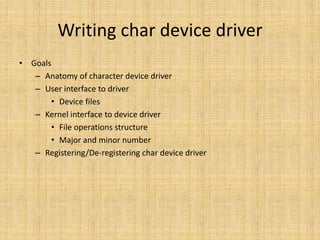
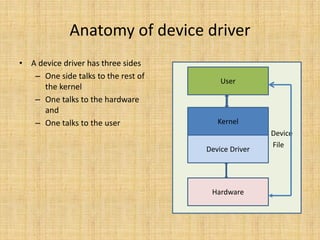
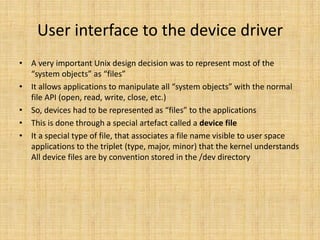
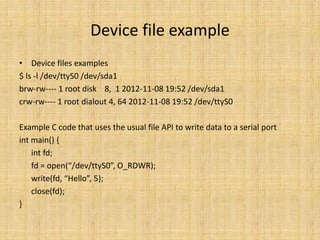
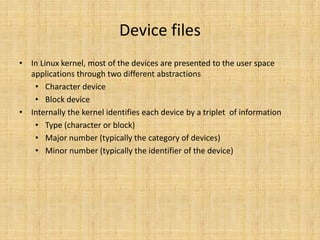
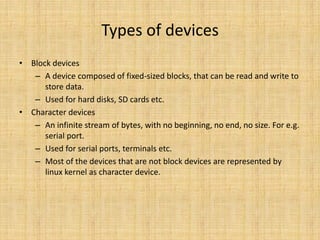
![Creating device files
ŌĆó On a basic Linux system, the device files can be created manually using the
mknod command
ŌĆó mknod /dev/<device> [c|b] major minor
ŌĆó Needs root privileges
ŌĆó Coherency between device files and devices handled by the kernel is
left to the system developer
ŌĆó On more elaborate Linux systems, mechanisms can be added to
create/remove them automatically when devices appear and
disappear
ŌĆó devtmpfs virtual filesystem, since kernel 2.6.32
ŌĆó udev daemon, solution used by desktop and server Linux systems
ŌĆó mdev program, a lighter solution than udev](https://image.slidesharecdn.com/introductiontochardevdriver-130402122525-phpapp01/85/Introduction-to-char-device-driver-7-320.jpg)
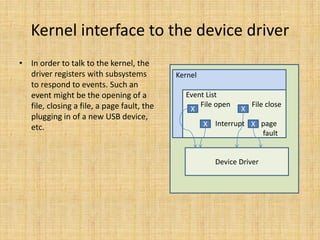
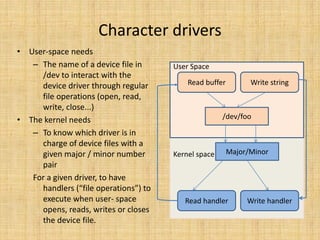
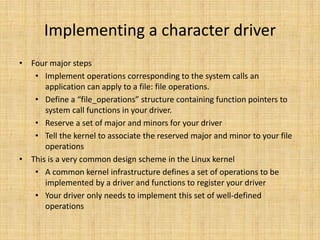
![File operations
ŌĆó Before registering character devices, you have to define file_operations
(called fops) for the device files.
ŌĆó The file_operations structure is generic to all files handled by the Linux
kernel.
ŌĆó Here are the most important operations for a character driver. All of them
are optional. (include/linux/fs.h)
struct file_operations {
ssize_t (*read) (struct file *, char __user *, size_t, loff_t *);
ssize_t (*write) (struct file *, const char __user *, size_t, loff_t *);
long (*unlocked_ioctl) (struct file *, unsigned int, unsigned long);
int (*open) (struct inode *, struct file *);
int (*release) (struct inode *, struct file *);
[...]
};](https://image.slidesharecdn.com/introductiontochardevdriver-130402122525-phpapp01/85/Introduction-to-char-device-driver-11-320.jpg)

